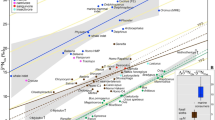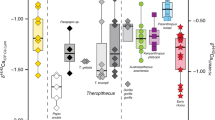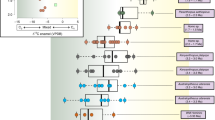Abstract
The mode of life of the early Tertiary giant bird Gastornis has long been a matter of controversy. Although it has often been reconstructed as an apex predator feeding on small mammals, according to other interpretations, it was in fact a large herbivore. To determine the diet of this bird, we analyze here the carbon isotope composition of the bone apatite from Gastornis and contemporaneous herbivorous mammals. Based on 13C-enrichment measured between carbonate and diet of carnivorous and herbivorous modern birds, the carbonate δ13C values of Gastornis bone remains, recovered from four Paleocene and Eocene French localities, indicate that this bird fed on plants. This is confirmed by a morphofunctional study showing that the reconstructed jaw musculature of Gastornis was similar to that of living herbivorous birds and unlike that of carnivorous forms. The herbivorous Gastornis was the largest terrestrial tetrapod in the Paleocene biota of Europe, unlike the situation in North America and Asia, where Gastornis is first recorded in the early Eocene, and the largest Paleocene animals were herbivorous mammals. The structure of the Paleocene terrestrial ecosystems of Europe may have been similar to that of some large islands, notably Madagascar, prior to the arrival of humans.




Similar content being viewed by others
References
Andors AV (1992) Reappraisal of the Eocene groundbird Diatryma (Aves: Anserimorphae). Sci Ser Nat Hist Mus Los Angel County 36:109–125
Andors AV (1995) Diatryma among the dinosaurs. Nat Hist 104:68–71
Angst D, Buffetaut E (2013) The first mandible of Gastornis HÉBERT, 1855 (Aves, Gastornithidae) from the Thanetian (Paleocene) of Mont-de-Berru (France). Rev Paléobiol 32:423–432
Archibald JD (1996) Dinosaur extinction and the end of an era: what the fossils say. Columbia University Press, New York
Baumel JJ, King AS, Breazile JE, Evans HE, Vanden Berge JC (1993) Handbook of avian anatomy : nomina anatomica avium, 2nd edn. Publications of the Nuttall Ornithological Club, Cambridge
Blake RE, O’Neil JR, Garcia G (1997) Oxygen isotope systematics of biologically mediated reactions of phosphate: I. Microbial degradation of organophosphorus compounds. Geochim Cosmochim Acta 61:4411–4422
Bourdon E, Cracraft J (2011) Gastornis is a terror bird: New insights into the evolution of the Cariamae (Aves, Neornithes). Soc Vert Paleont Ann Meet Abstr 31:75–75
Buffetaut E (1997) L’oiseau géant Gastornis : interprétation, reconstitution et vulgarisation de fossiles inhabituels dans la France du XIXe siècle. Bull Soc Geol Fr 168:805–811
Buffetaut E, Angst D (2013) Terror cranes or peaceful plant-eaters: changing interpretations of the palaeobiology of gastornithids birds. Rev Paléobiol 32:413–422
Cerling TE, Harris JM (1999) Carbon isotope fractionation between diet and bioapatite in ungulate mammals and implications for ecological and paleoecological studies. Oecologia 120:347–363
Clabaut CA, Herrel A, Sanger TJ, Smith TB, Abzhanov A (2009) Development of beak polymorphism in the African seedcracker, Pyrenestes ostrinus. Evol Deve 11:636–646
Collinson ME, Manchester SR, Wilde V (2012) Fossil fruits and seeds of the Middle Eocene Messel biota, Germany. Abh Senckenberg Ges Naturforsch 570:1–251
De Niro MJ, Epstein S (1978) Influence of diet on the distribution of carbon isotopes in animals. Geochim Cosmochim Acta 42:495–506
Genbrugge A, Herrel A, Boone M, Van Hoorebeke L, Podos J, Dirckx J, Aerts P, Adriaens D (2011) The head of the finch: a detailed analysis of the feeding apparatus in two species of finches (Geospiza fortis and Padda oryzivora). J Anat 219:676–695
Johnson BJ, Fogel ML, Miller GH (1998) Stable isotopes in modern ostrich eggshell: A calibration for paleoenvironmental applications in semi-arid regions of southern Africa. Geochim Cosmochim Acta 62:2451–2461
Kelly JK (2000) Stable isotopes of carbon and nitrogen in the study of avian and mammalian trophic ecology. Can J Zool 78:1–27
Koch PL (1998) Isotopic reconstruction of Past Continental Environments. Annu Rev Earth Planet Sci 26:573–613
Koch PL (2007) Isotopic study of the biology of modern and fossil vertebrates. In: Michener R, Lajtha K (eds) Stable isotopes in ecology and environmental science, 2nd edn. Blackwell Publishing, Malden, pp 99–154
Koch PL, Turos N, Fogel ML (1997) The effects of sample treatment and diagenesis on the isotopic integrity of carbonate in biogenic hydroxylapatite. J Archaeol Sci 24:417–429
Kohn MJ (2010) Carbon isotope compositions of terrestrial C3 plants as indicators of (paleo)ecology and (paleo)climate. Proc Natl Acad Sci 107:19691–19695
Krueger HW, Sullivan CH (1984) Model for carbon isotope fractionation between diet and bone. Stable isotopes Nutr 258:205–220
Le Geros RZ, Le Geros JP (1984) Phosphate minerals in human tissues. In: Nriagu JO, Moore PB (eds) Phosphate Miner. Springer, Heidelberg, pp 351–385
Lécuyer C, Grandjean P, Sheppard SMF (1999) Oxygen isotope exchange between dissolved phosphate and water at temperatures ≤135 °C: inorganic versus biological fractionations. Geochim Cosmochim Acta 63:855–862
Lee-Thorp J, Van Der Merwe N (1987) Carbon isotope analysis of fossil bone apatite. S Afr J Sci 83:712–715
Loeb GE, Gans C (1986) Electromyography for Experimentalists. University of Chicago Press, Chicago
Mendez J, Keys A, Anderson JT, Grande F (1960) Density of fat and bone mineral of the mammalian body. Metabolism 9:472–477
Metscher B (2009) MicroCT for comparative morphology: simple staining methods allows high-contrast 3D imaging of diverse non-mineralized animal tissues. BCM Physiol 9:1–14
Michel V, Ildefonse P, Morin G (1995) Chemical and structural changes in Cervus elaphus tooth enamels during fossilization (Lazaret cave): a combined IR and XRD Rietveld analysis. Appl Geochem 10:145–159
Miller GH, Magee JW, Johnson BJ, Fogel ML, Spooner NA, McCulloch MT, Ayliffe LK (1999) Pleistocene extinction of Genyornis newtoni: human impact on Australian megafauna. Science 283:205–208
Murray PF, Vickers-Rich P (2004) Magnificent Mihirungs. The colossal flighless birds of the Australian dreamtime. Indiana University Press, Baltimore and Indianapolis
Passey BH, Robinson TF, Ayliffe LK, Cerling TE, Sponheimer M, Dearing MD, Roeder BL, Ehleringer GL (2005) Carbon isotope fractionation between diet, breath CO2, and bioapatite in different mammals. J Archaeol Sci 32:1459–1470
Rose KD (2009) The beginning of the age of mammals. The Johns Hopkins University Press, Baltimore
Tütken T, Held P, Galer SJG (2013) Isotopes in vertebrate bioapatite: proxies for climate, pCO2 and diet. Miner Mag 77:2368–2368
Witmer LM, Rose KD (1991) Biomechanics of the jaw apparatus of the gigantic Eocene bird Diatryma: implications for diet and mode of life. Paleobiology 17:95–120
Zazzo A, Lécuyer C, Mariotti A (2004) Experimentally-controlled carbon and oxygen isotope exchange between bioapatites and water under inorganic and microbially-mediated conditions. Geochim Cosmochim Acta 68:1–12
Acknowledgments
We thank Florent Goussard, Patricia Wills, and Alexis Dollion for their help with CT scanning and segmentation of bird mandibles. Thanks to Ronan Allain and Christine Argot (MNHN, Paris), Loïc Costeur (NHM, Basel), Yves Laurent (MHN, Toulouse), Emmanuel Robert (UCBL, Lyon), and Alain Phelizon (Châlons-en-Champagne) for the permission to sample fossils for the geochemical analysis. Thanks to Marie and Pascal Grussenmeyer from the Ferme de l’Autruche Drômoise (Livron, Drôme) and Géraldine Blanchon-Pothet from the Parc aux Oiseaux des Dombes (Villars-les-Dombes, Ain) for the access to living birds, their eggshells, and their food. Thanks to Paul Wheeler from IsoPrims UK ltd for the access to their IRMS facility in Manchester. This work was supported by a grant from the INTERRVIE program of the Institut National des Sciences de l'Univers.
Author information
Authors and Affiliations
Corresponding author
Additional information
Communicated by: Sven Thatje
Rights and permissions
About this article
Cite this article
Angst, D., Lécuyer, C., Amiot, R. et al. Isotopic and anatomical evidence of an herbivorous diet in the Early Tertiary giant bird Gastornis. Implications for the structure of Paleocene terrestrial ecosystems. Naturwissenschaften 101, 313–322 (2014). https://doi.org/10.1007/s00114-014-1158-2
Received:
Revised:
Accepted:
Published:
Issue Date:
DOI: https://doi.org/10.1007/s00114-014-1158-2




